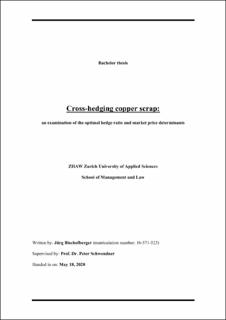Bitte benutzen Sie diese Kennung, um auf die Ressource zu verweisen:
https://doi.org/10.21256/zhaw-21506| Publikationstyp: | Thesis: Bachelor |
| Titel: | Cross-hedging copper scrap : an examination of the optimal hedge ratio and market price determinants |
| Autor/-in: | Bischofberger, Jürg |
| Betreuer/-in / Gutachter/-in: | Schwendner, Peter |
| DOI: | 10.21256/zhaw-21506 |
| Umfang: | 69 |
| Erscheinungsdatum: | 2020 |
| Verlag / Hrsg. Institution: | ZHAW Zürcher Hochschule für Angewandte Wissenschaften |
| Verlag / Hrsg. Institution: | Winterthur |
| Sprache: | Englisch |
| Fachgebiet (DDC): | 338: Produktion |
| Zusammenfassung: | Copper is a unique metal, which finds due to its particular characteristics a wide range of applications. There is a large demand for the material, which is only available in very limited amounts. The supplied quantities thereby not only depend on various mines all over the world but also on recycled copper scrap from scrap yards. Overall, this constellation creates an extensive global market with volatile price movements. In order to reduce price risk, copper scrap traders often engage in trading futures contracts at the London Metal Exchange. Their goal is to offset losses in their physical positions with price movements from opposed financial positions. The ratio between the two positions is called “hedge ratio”. This research’s aim is to determine the optimal hedge ratio that a copper scrap trader should apply when hedging a physical position on the LME futures market. While in the industry the hedge ratio of 1.0 (in the research community often called “naïve hedge ratio”) is commonly applied, it is not given that the LME copper futures prices and copper scrap prices move exactly simultaneously. Therefore, the naïve hedge ratio can lead to remaining open positions and consequently also to unnecessary and undesired risk-taking. Also, other market price determinants of the copper scrap market are examined. The aim is to provide traders a deeper insight into the mechanics of the scrap markets. The focus is thereby mainly on the deductions for different scrap qualities, the LME warehouse stock and the LME copper basis. The applied methods rely strongly on linear regression respectively the ordinary least square model. This research focuses on the European copper market and uses millberry and refinery material to represent different qualities of copper scrap. The data set used ranges from the end of 2011 until the beginning of 2020. The findings show that over the last eight years a hedge ratio lower than 1.0 would have been more efficient when hedging on a horizon of three months. Concretely, while for millberry a hedge ratio of 0.95 would have been optimal, refinery material would have been hedged most effectively with a ratio of 0.88. Nevertheless, an out-of-sample test further outlines that such a stationary hedge ratio is not consistently outperforming the naïve hedge ratio. Further investigations point out that the hedge ratio in itself is subject to rather strong variations, which is why a dynamic hedge ratio might be the better choice compared to the stationary counterpart. A portfolio simulation with dynamic hedge ratios and different window lengths shows a better overall performance and therefore supports this hypothesis. In conclusion, this research suggests that trading firms can reduce the price volatility of their copper portfolios by adopting a dynamic hedge ratio instead of the commonly applied naïve hedge ratio. Further, an analysis of the above-mentioned market price determinants shows that deductions for copper scrap materials have a tendency to move similarly. However, a relationship between the deductions and the LME warehouse stock data respectively the LME basis was not found. |
| URI: | https://digitalcollection.zhaw.ch/handle/11475/21506 |
| Lizenz (gemäss Verlagsvertrag): | CC BY 4.0: Namensnennung 4.0 International |
| Departement: | School of Management and Law |
| Enthalten in den Sammlungen: | BSc Betriebsökonomie |
Dateien zu dieser Ressource:
| Datei | Beschreibung | Größe | Format | |
|---|---|---|---|---|
| Thesis_Bachelorarbeit_Cross-hedging copper scrap_Juerg Bischofberger.pdf | 924.86 kB | Adobe PDF |  Öffnen/Anzeigen |
Zur Langanzeige
Bischofberger, J. (2020). Cross-hedging copper scrap : an examination of the optimal hedge ratio and market price determinants [Bachelor’s thesis, ZHAW Zürcher Hochschule für Angewandte Wissenschaften]. https://doi.org/10.21256/zhaw-21506
Bischofberger, J. (2020) Cross-hedging copper scrap : an examination of the optimal hedge ratio and market price determinants. Bachelor’s thesis. ZHAW Zürcher Hochschule für Angewandte Wissenschaften. Available at: https://doi.org/10.21256/zhaw-21506.
J. Bischofberger, “Cross-hedging copper scrap : an examination of the optimal hedge ratio and market price determinants,” Bachelor’s thesis, ZHAW Zürcher Hochschule für Angewandte Wissenschaften, Winterthur, 2020. doi: 10.21256/zhaw-21506.
BISCHOFBERGER, Jürg, 2020. Cross-hedging copper scrap : an examination of the optimal hedge ratio and market price determinants. Bachelor’s thesis. Winterthur: ZHAW Zürcher Hochschule für Angewandte Wissenschaften
Bischofberger, Jürg. 2020. “Cross-Hedging Copper Scrap : An Examination of the Optimal Hedge Ratio and Market Price Determinants.” Bachelor’s thesis, Winterthur: ZHAW Zürcher Hochschule für Angewandte Wissenschaften. https://doi.org/10.21256/zhaw-21506.
Bischofberger, Jürg. Cross-Hedging Copper Scrap : An Examination of the Optimal Hedge Ratio and Market Price Determinants. ZHAW Zürcher Hochschule für Angewandte Wissenschaften, 2020, https://doi.org/10.21256/zhaw-21506.
Alle Ressourcen in diesem Repository sind urheberrechtlich geschützt, soweit nicht anderweitig angezeigt.